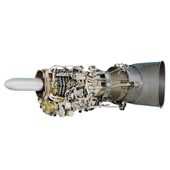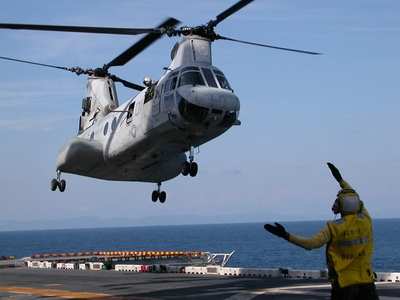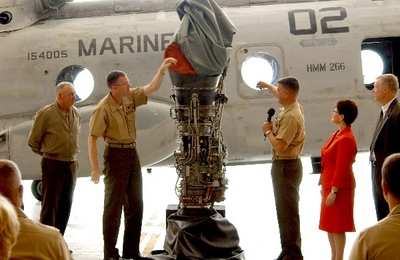Company's First Small Turbine
 During a rousing
ceremony held on March 27, hundreds of employees, retirees,
customers and military dignitaries commemorated the 50th year of
flight for one of GE Aviation's and the U.S. Marine Corps' most
successful and durable helicopter engines, the T58.
During a rousing
ceremony held on March 27, hundreds of employees, retirees,
customers and military dignitaries commemorated the 50th year of
flight for one of GE Aviation's and the U.S. Marine Corps' most
successful and durable helicopter engines, the T58.
Originally conceptualized in the early 1950s, the T58 was
designed under sponsorship of the Navy Bureau of Aeronautics as a
lightweight, compact helicopter powerplant. The T58 was GE's first
small turbine engine and, by the early 1960s, it had evolved into
one of the bread-and-butter production engine programs for the Lynn
plant.
In recapping the history of the T58 and citing its impressive
list of technological firsts, Ed Birtwell, vice president of GE's
Turboshaft/Turboprop Project Department, commented, "It is clear
that the mighty T58 was instrumental in the evolution and
popularity of one of the 20th century's key innovations, the
helicopter. The T58 is woven into the fabric of aviation around the
world."
In 1957, two T58 engines powered a Sikorsky HSS-1F helicopter in
the first jet-powered flight of a United States' helicopter. Other
T58 applications grew to include the Sikorsky SH-3 Sea King
anti-submarine helicopter, the Boeing CH-46 Sea Knight assault
transport (currently the top T58 application with 218 CH-46E
helicopters in U.S. Marine Corps service), the Kaman SH-2 Seasprite
Light Airborne Multi-Purpose System (LAMPS), and specific models of
the Bell UH-1 "Huey" helicopter. The most visible T58-powered
aircraft is the Sikorsky VH-3D that, for more than 40 years, has
provided transportation for the president of the United States and
other members of the executive branch.
Col. Andrew O'Donnell, commanding officer HMX-1, has piloted
T58-powered helicopters for four presidents. "Thank you for your
hard work and for the dedication of this facility in supporting
Marine One and our very prized package that we have been privileged
to fly for many years," said Col. O'Donnell.

Engine reliability and performance have been staples of the T58
for a half-century. T58 engine ratings grew from 1,050 to 1,870
shaft horsepower over the course of a production run from 1959 to
1984. The T58 has also benefited from an influx of technology and
materials over the years that have contributed to its exceptional
longevity.
Back in 2000, GE Aviation was awarded a $200 million T58 ERIP
(Engine Reliability Improvement Program) contract to upgrade 449
T58 engines powering U.S. Marine Corps CH-46E helicopters.
Beginning in 2003, GE re-started the T58 production line and
provided new engine cores that were then mated with accessories and
power turbines at the Cherry Point, N.C., Naval Air Depot. In
addition, a titanium nitride (TiN) coating process for compressor
blades was identified and subsequently incorporated into ERIP
engines, which helped reduce blade erosion and improved engine time
on wing. The final ERIP engine was shipped earlier this month.
"There is no doubt ERIP will save Marines' and sailors' lives
over the next 10 years as the Sea Knight is scheduled to fly until
2017," said Lt. Col. Harry Hewson, program manager Air 226.
"Anytime you can deliver a product under budget and ahead of
schedule, you have truly made a contribution to our
warfighters."

"The timing of the launch of the ERIP program couldn't have been
better, as new engines began arriving at a time when our country
was just beginning its war on terror," said Col. Bill Taylor, the
former CH-46 program manager who helped launch ERIP in 2000. "To
date, ERIP engines have accumulated more than 144,000 flight-hours,
much of that time in the harsh environments of Iraq, Afghanistan
and the Horn of Africa."
 NTSB Final Report: Rutan Long-EZ
NTSB Final Report: Rutan Long-EZ ANN FAQ: Turn On Post Notifications
ANN FAQ: Turn On Post Notifications Classic Aero-TV: ICAS Perspectives - Advice for New Air Show Performers
Classic Aero-TV: ICAS Perspectives - Advice for New Air Show Performers ANN's Daily Aero-Linx (06.28.25)
ANN's Daily Aero-Linx (06.28.25) Aero-News: Quote of the Day (06.28.25)
Aero-News: Quote of the Day (06.28.25)





